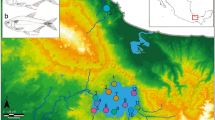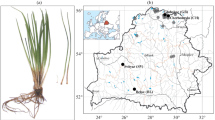Abstract
The limpet Nacella concinna (Strebel 1908) was the focus of numerous studies dealing with Antarctic benthos. One of the main characteristics of the species is the presence of two distinguishable morphotypes, one inhabiting the intertidal (during summer) and the other inhabiting the subtidal. For a long time these forms were considered as an expression of phenotypic plasticity, since previous studies did not found genetic differences between them. In the present work, we performed both a morphometric and a genetic differentiation analysis (using ISSR-PCR markers) of these two forms in three stations sampled at Potter Cove, South Shetland Islands. The results confirmed the morphological differences between intertidal and subtidal forms reported in other Antarctic localities. The genetic differences detected indicate that the two forms can be considered as genetically distinct populations maintaining low levels of gene flow. The degree of reproductive isolation of the ecotypes is discussed, as well as the possible origin of the divergence. The genetic differentiation observed can also have behavioral and physiological correlates, pointing out the importance of taking into account the potential differences in the response of both populations to different conditions in future studies in this species.






Similar content being viewed by others
References
Abbot P (2001) Individual and population variation in invertebrates revealed by Inter-simple sequence repeats (ISSRs). J Insect Sci 1:8
Abele D, Burlando B, Viarengo A, Pörtner H (1998) Exposure to elevated temperatures and hydrogen peroxide elicits oxidative stress and antioxidant response in the Antarctic intertidal limpet Nacella concinna. Comp Biochem Physiol B 120:425–435
Abele D, Puntarulo S (2004) Formation of reactive species and induction of antioxidant defence systems in polar and temperate marine invertebrates and fish. Comp Biochem Physiol A 138:405–415
Beaumont AR, Wei JHC (1991) Morphological and genetic variation in the Antarctic limpet Nacella concinna (Strebel, 1908). J Molluscan Stud 57:443–450
Bernardi G, Goswami U (1997) Molecular evidence for cryptic species among the Antarctic fish Trematomus bernacchii and Trematomus hansoni. Antarct Sci 9:381–385
Biebach H (1983) Genetic determination of partial migration in the European robin (Erithacus rubecula). Auk 100:601–606
Black WC IV (1997) FORTRAN programs for the analysis of RAPD-PCR data. http://lamar.colostate.edu/pub/wbc4
Bornet B, Branchard M (2001) Nonanchored inter simple sequence repeat (ISSR) markers: reproducible and specific tools for genome fingerprinting. Plant Mol Biol Rep 19:209–215
Brêthes JC, Ferreyra G, de la Vega S (1994) Distribution, growth and reproduction of the limpet Nacella (Patinigera) concinna (Strebel 1908) in relation to potential food availability, in Esperanza Bay (Antarctic Peninsula). Polar Biol 14:161–170
Bruford ME, Hanotte O, Brookfield JFY, Burke T (1992) Single-locus and multilocus DNA fingerprinting. In: Hoelzel AR (ed) Molecular genetic analysis of populations, a practical approach. Oxford University Press, Oxford, pp 225–269
Casu M, Maltagliati F, Cossu P, Lai T, Curini Galletti M, Castelli A, Commito JA (2005) Fine-grained spatial genetic structure in the bivalve Gemma gemma from Maine and Virginia (USA), as revealed by inter-simple sequence repeat markers. J Exp Mar Biol Ecol 325:46–54
Casu M, Casu D, Lai T, Cossu P, Curini-Galleti M (2006) Inter-simple sequence repeat markers reveal strong genetic differentiation among populations of the endangered mollusc Patella ferruginea (Gastropoda: Patellidae) from two Sardinian marine protected areas. Mar Biol 149:1163–1174
Chambers RJ, McQuaid CD, Kirby R (1998) The use of randomly amplified polymorphic DNA to analyze the genetic diversity, the systematic relationships and the evolution of intertidal limpets, Siphonaria spp. (Pulmonata: Gastropoda), with different reproductive modes. J Exp Mar Biol Ecol 227:49–66
Clark M, Fraser K, Peck L (2007a) Antarctic marine molluscs do have an HSP70 heat shock response. Cell Stress Chaperones (in press)
Clark M, Geissler P, Waller C, Fraser K, Barnes D, Peck P (2007b) Low heat shock thresholds in wild Antarctic intertidal limpets (Nacella concinna) Cell Stress Chaperones (in press)
Clarke A, Prothero-Thomas E, Beaumont JC, Chapman AL, Brey T (2004) Growth in the limpet Nacella concinna from contrasting sites in Antarctica. Polar Biol 28:62–71
Culley TM, Wolfe AD (2001) Population genetic structure of the cleistogamous plant species Viola pubescens Aiton (Violaceae), as indicated by allozyme and ISSR molecular markers. Heredity 86:545–556
Davenport J (1988) Tenacity of the Antarctic limpet Nacella concinna. J Molluscan Stud 54:355–356
Estoup A, Rousset F, Michalakis Y, Cornuet JM, Adriamanga M, Guyomard R (1998) Comparative analysis of microsatellite and allozyme markers: a case study investigating microgeographic differentiation in brown trout (Salmo trutta). Mol Ecol 7:339–353
Fraser KPP, Clarke A, Peck L (2002a) Low-temperature protein metabolism: seasonal changes in protein synthesis and RNA dynamics in the Antarctic limpet Nacella concinna (Strebel 1908). J Exp Biol 205:3077–3086
Fraser KPP, Clarke A, Peck L (2002b) Feast and famine in Antarctica: seasonal physiology in the limpet Nacella concinna. Mar Ecol Prog Ser 242:169–177
Goudet J (1999) PCAGEN. Principal components analysis of gene frequency data (version 1.2). Population Genetics Laboratory, University of Lausanne, Lausanne. http://www2.unil.ch/popgen/softwares/pcagen.htm
Hammer Ø, Harper DAT, Ryan PD (2001) PAST: palaeontological Statistics software package for education and data analysis. Palaentol Electronica 4(1):9. http://folk.uio.no/ohammer/past
Held C (2003) Molecular evidence for cryptic speciation within the widespread Antarctic crustacean Ceratoserolis trilobitoides (Crustacea, Isopoda). In: Huiskes AHL, Gieskes WWC, Rozema J, Schorno RML, van der Vies SM, Wolff WJ (eds) Antarctic biology in a global context. Backhuys, Leiden, pp 135–139
Held C, Leese F (2006) The utility of fast evolving molecular markers for studying speciation in the Antarctic benthos. Polar Biol 30(4):513–521
Held C, Wägele J-W (2005) Cryptic speciation in the giant Antarctic isopod Glyptonotus antarcticus (Isopoda: Valvifera: Chaetiliidae). Sci Mar 69:175–181
Hellberg ME, Burton RS, Neigel JE, Palumbi SR (2002) Genetic assessment of connectivity among marine populations. Bull Mar Sci 70(1):273–290
Hollander J, Lindergarth M, Johannesson K (2005) Local adaptation but not geographical separation promotes assortative mating in a snail. Anim Behav 70:1209–1219
Holsinger KE, Lewis PO (2003) HICKORY v. 1.1. Department of Ecology and Evolutionary Biology, The University of Connecticut. http://www.eeb.unconn.edu/
Hou L, Lü H, Zou X, Bi X, Yan D, He C (2006) Genetic characterizations of Mactra veneriformis (Bivalve) along the Chinese coast using ISSR-PCR markers. Aquaculture 261:865–871
InfoStat (2002) InfoStat versión 1.1. Grupo InfoStat, FCA. Universidad Nacional de Córdoba, Argentina
In-Young A, Ko-Woon K, Heeseon JC (2002) A baseline study on metal concentrations in the Antarctic limpet Nacella concinna (Gastropoda: Patellidae) on King George Island: variations with sex and body parts. Mar Pollut Bull 44:421–431
Johannesson K (2003) Evolution in Littorina: ecology matters. J Sea Res 49:107–117
Kent JW Jr, Rankin MA (2001) Heritability and physiological correlates of migratory tendency in the grasshopper Melanoplus sanguinipes. Physiol Entomol 26:371–380
Luque C, Legal L, Staudter H, Gers C, Wink M (2002) Brief report ISSR (inter simple sequence repeats) as genetic markers in Noctuids (Lepidoptera). Hereditas 136:251–253
Lynch LM, Milligan G (1994) Analysis of population genetic structure with RAPD markers. Mol Ecol 3:91–99
Markowska M, Kidawa A (2007) Encounters between Antarctic limpets, Nacella concinna, and predatory sea stars, Lysasterias sp., in laboratory and field experiments. Mar Biol 151:1959–1966
Nolan CP (1991) Size, shape and shell morphology in the Antarctic limpet Nacella concinna at Signy Island, South Orkney Islands. J Molluscan Stud 57:225–238
Panova M, Hollander J, Johannesson K (2006) Site-specific genetic divergence in parallel hybrid zones suggests nonallopatric evolution of reproductive barriers. Mol Ecol 15:4021–4031
Peck L, Veal R (2001) Feeding, metabolism and growth in the Antarctic limpet, Nacella concinna (Strebel 1908). Mar Biol 138:553–560
Picken GB (1980) The distribution, growth and reproduction of the Antarctic limpet Nacella (Patinigera) concinna (Strebel 1908). J Exp Mar Biol Ecol 42:71–85
Picken GB, Allan D (1983) Unique spawning behaviour by the Antarctic limpet Nacella (Patinigera) concinna (Strebel 1908). J Exp Mar Biol Ecol 71:283–287
Powell AWB (1973) The patellid limpets of the world (Patellidae). Indo Pac Molluscan 3:75–206
Powell DK, Tyler PA, Peck LS (2001) Effects of sperm concentration and sperm ageing on fertilisation success in the Antarctic soft-shelled clam Laternula elliptica and the Antarctic limpet Nacella concinna. Mar Ecol Prog Ser 215:191–200
Pulido F, Berthold P, Mohr G, Querner U (2001) Heritability of the timing of autumn migration in a natural bird population. Proc R Soc Lond 268:953–959
Raghava GPS (1994) Improved estimation of DNA fragment lengths from DNA gene electrophoresis using a graphical method. Biotechniques 17:100–104
Raupach MJ, Wägele J-W (2006) Distinguishing cryptic species in Antarctic Asellota (Crustacea: Isopoda)—a preliminary study of mitochondrial DNA in Acanthaspidia drygalskii. Antarct Sci 18:191–198
Rolán-Alvarez E, Carballo M, Galindo J, Morán P, Fernández B, Caballero A, Cruz R, Boulding EG, Johannesson K (2004) Nonallopatric and parallel origin of local reproductive barriers between two snail ecotype. Mol Ecol 13:3415–3424
Sunnucks P (2000) Efficient genetic markers for population biology. Trends Ecol Evol 15:199–203
Walker AJM (1972) Introduction to the ecology of the Antarctic limpet Patinigera polaris (Hombron and Jaquinot) at Signy Island, South Orkney Island. Br Antarct Surv Bull 28:49–71
Waples RS, Gaggiotti O (2006) What is a population? An empirical evaluation of some genetic methods for identifying the number of gene pools and their degree of connectivity. Mol Ecol 15:1419–1439
Weir BS, Cockerham CC (1984) Estimating F-statistic for the analysis of population structure. Evolution 38(6):1358–1370
Wilding CS, Butlin RK, Grahame J (2001) Differential gene exchange between parapatric morphs of Littorina saxatilis detected using AFLP markers. J Evol Biol 14:611–619
Zietkiewicz E, Rafalski A, Labuda D (1994) Genome fingerprinting by simple sequence repeat (SSR)-anchored polymerase chain reaction amplification. Genomics 20:176–183
Acknowledgments
We are grateful to the members of Jubany station for their cooperation in the field work especially to J. Antacli and A. Stellfeldt. We are also grateful to Doris Abele, Melody Clark and three anonymous reviewers whose comments and suggestions greatly improved this manuscript. We also thank the Instituto Antártico Argentino and CONICET for their financial and logistic support.
Author information
Authors and Affiliations
Corresponding author
Additional information
Communicated by T. Reusch.
M. C. de Aranzamendi and R. Sahade contributed equally to this paper.
Rights and permissions
About this article
Cite this article
de Aranzamendi, M.C., Sahade, R., Tatián, M. et al. Genetic differentiation between morphotypes in the Antarctic limpet Nacella concinna as revealed by inter-simple sequence repeat markers. Mar Biol 154, 875–885 (2008). https://doi.org/10.1007/s00227-008-0980-5
Received:
Accepted:
Published:
Issue Date:
DOI: https://doi.org/10.1007/s00227-008-0980-5




